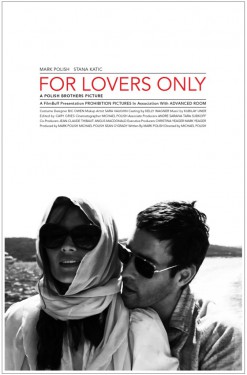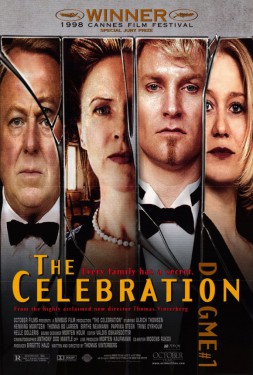 Back to selection
Back to selection
The Microbudget Conversation
We're Only Talking a Few Thousand Dollars by John Yost
The Microbudget Conversation: The No-Budget Way

I am overwhelmed and excited by the response from our last post…this truly is the conversation in action, and the reason I wanted to start this column. We also just got the word that our panel for SXSW is up on their site and ready to vote for. If you want to see us bring the conversation to SXSW then vote here! Many thanks in advance!
In keeping with the idea of necessity and budget constraints from Nicole’s piece, I present to you with Mark Stolaroff. Mark is the fella behind the No-Budget Film School in L.A. and he’s here to get you hooked on the no-budget philosophy. No Budget is about to start another round of classes with a number of great names attached. He’s even got the filmmakers of Bellflower, which tells me that not only is he up-to-date on what’s happening in our industry but he also has good taste.
 I imagine that most people who take my “Art & Science of No-Budget Filmmaking” class already have a project that they know they want to make and because they don’t have the necessary money to make it, are trying to figure out how to make it for less. That means they’re coming in with a film that should cost, let’s say $200,000, and they’re trying to figure out — they’re hoping I can instruct them — how to make it for, say, $50,000. These numbers obviously vary, but the thought process is the same. I also imagine that for these folks, the first couple of hours of my class may seem like a waste of time. This is the “philosophy” part. The introduction to the introduction. The part of the cooking show where the chef tells you how he came to like the dish and the importance of each ingredient, as opposed to cracking some eggs and sautéing some mushrooms.
I imagine that most people who take my “Art & Science of No-Budget Filmmaking” class already have a project that they know they want to make and because they don’t have the necessary money to make it, are trying to figure out how to make it for less. That means they’re coming in with a film that should cost, let’s say $200,000, and they’re trying to figure out — they’re hoping I can instruct them — how to make it for, say, $50,000. These numbers obviously vary, but the thought process is the same. I also imagine that for these folks, the first couple of hours of my class may seem like a waste of time. This is the “philosophy” part. The introduction to the introduction. The part of the cooking show where the chef tells you how he came to like the dish and the importance of each ingredient, as opposed to cracking some eggs and sautéing some mushrooms.
Now, I will say to those of you who have never taken my class that I DO cover the cracking of the eggs. As someone who on multiple occasions has had to take a higher-budget film and make it for considerably less, I know how to do this and I have done my best to quantify the model so others can do it too. But I qualify all of that cramming of big round pegs into small round holes in the first two hours. I ask my students to first take that project they thought they wanted to make and put it on the shelf — at least for a moment — and think about a new way to make movies, a way that will most likely not involve that project they walked in with.
Of course this new way — something I call the No Budget Way — is partially a necessity. Perhaps it’s the only way for some people who have few monetary resources to make a film, any film. For those folks it’s non-discretionary. It’s something you have to do, whether you like it or not, but really I feel like it should be a discretionary way to make a movie for everyone. If done “properly,” it should be a liberating process, the way you would always want to make a film, though not the way you could make any and every kind of film. You couldn’t make Harry Potter using the principles of the No Budget Way. However, if you were the Polish Brothers, you could use it from time to time, even when people are giving you money to make bigger films the more conventional way. Their recent film, For Lovers Only (pictured above), which they supposedly made for $0 and have already grossed $200,000 on, was pretty much made in the No Budget Way. 
The NBW is a zen-like way of being more than a set of rules. It’s an optional list that puts you in the proper state-of-mind to make something special, and to make it in a liberating way that forces you to focus on the storytelling at hand. Maybe I can best explain it like Miles explains it to Joel in Risky Business, when he’s trying to get him to loosen up: “Joel, you wanna know something? Every now and then say, ‘What the fuck.’ ‘What the fuck’ gives you freedom. Freedom brings opportunity. Opportunity makes your future.” The No Budget Way gives you the freedom to say “What the fuck” and let go of things that aren’t important and concentrate on the critical things that are, (and certainly it has made the future bright for a number of filmmakers over the years). When you have lots of money and professionals in every position, you don’t have that freedom. When it’s just you and a couple of close friends and a tiny bit of money, you’re going to have to let go of something, probably a lot of things. For many this is a painful process, but it doesn’t have to be and shouldn’t be at all. It starts with something I call “Embracing Your Limitations” and every successful micro-budget filmmaker has done this intuitively. It’s allowing yourself to let go of the things that you can’t have, the things you can’t control, and embrace the things that are most crucial toward the success of your film. Those things are almost always just story and performances, (and often within that, truth and authenticity). Fortunately, the American Independent Film Consortium of journalists (like those in Filmmaker Magazine and Indiewire), film festival programmers, (especially those at top fests like Sundance and SXSW), and arthouse audiences (for the most part), will support and reward you for doing this.
So what is this Embracing of Limitations and what does it entail? It starts, again, with necessity. It starts with “Refusing To Spend Money.” This is the very first “rule” in my class and it sounds simple, but like breaking up, it is oooohhh so hard to do. If you’ve budgeted your film for $5,000 and have $10,000, you’re going to spend the $10,000. But refusing to spend money isn’t just a rule to keep you out of debt, it’s there to get you into the proper frame of mind. It allows you to let go; To say “what the fuck.” Once you start saying, “We’re just not going to spend that,” you start opening up that part of your vessel where the creative energy lies. That energy is the secret vital element of successful micro-budget filmmaking. Talent is important, but talent needs passion to create something special. I can’t tell you why someone like Francis Coppola made two or three of the greatest movies ever and now makes shit, but I have a feeling it has something to do with this. Not spending money and figuring out another way to do it forces you to use your imagination, and that’s the part of your mind you want to use on a creative endeavor, right?
 That positive energy also comes from accepting your limitations to the degree where they no longer become limitations, but rather opportunities and advantages. I like to use the example of Dogma 95 to explain this one. These Danish guys got together and made up a crazy set of rules to make their films by, and while it might seem impossible to make any film under these conditions, they in fact made a series of great films under these rules. The first one, The Celebration is considered by many to be one of the best indie films of the 1990’s. But most people got the lesson of their success all wrong. They attributed it to the specific rules they laid out, rather than the fact that they chose to work with rules at all. So a bunch of other filmmakers ran out and started making films utilizing this same set of rules, as if these were the only rules that could generate great cinema. An interview with Lars Von Trier, one of the ringleaders of the movement, reveals that the rules were rather arbitrary. These filmmakers were bored with making films the same old ways and thought it would be an interesting experiment to make them under a set of restrictive rules. They knew that these restrictions would fuel their imagination and sure enough, great movies came out the other end. All the other stuff around the rules — the manifesto — was just marketing and goofing around.
That positive energy also comes from accepting your limitations to the degree where they no longer become limitations, but rather opportunities and advantages. I like to use the example of Dogma 95 to explain this one. These Danish guys got together and made up a crazy set of rules to make their films by, and while it might seem impossible to make any film under these conditions, they in fact made a series of great films under these rules. The first one, The Celebration is considered by many to be one of the best indie films of the 1990’s. But most people got the lesson of their success all wrong. They attributed it to the specific rules they laid out, rather than the fact that they chose to work with rules at all. So a bunch of other filmmakers ran out and started making films utilizing this same set of rules, as if these were the only rules that could generate great cinema. An interview with Lars Von Trier, one of the ringleaders of the movement, reveals that the rules were rather arbitrary. These filmmakers were bored with making films the same old ways and thought it would be an interesting experiment to make them under a set of restrictive rules. They knew that these restrictions would fuel their imagination and sure enough, great movies came out the other end. All the other stuff around the rules — the manifesto — was just marketing and goofing around.
So, if creating rules (or restrictions) can help you make better movies, then why use their restrictions? Jesus, people, you’ve already got your own! Just don’t think of them as limitations, think of them as rules to make your movie by. Think of conforming to these new rules as a creative experiment that feeds your creativity and sparks your imagination.
One of my favorite recent stories of just how to do this was demonstrated in the narrative feature Lord Byron, Zack Godshall’s no-budget film that premiered in the NEXT section at this year’s Sundance Film Festival. Zack had no money, and in fact, made the film for only $700. Most people will ask, “How did you make a film for only $700?” and I would say his answer would be “refuse to spend money.” But then the astute filmmaker would follow up with, “but how do you do that? It’s just so hard to do!” Zack did something instinctively right at the beginning that made that process much easier. Rather than sweat over which camera to use — a choice that most micro-budget filmmakers spend waaaay too much time considering when it is in fact one of the least important decisions that they have to make — he instead used the camera he had lying around, an old Sony Z1U. For those of you not familiar with the Z1, it was pretty much the first HDV camera on the market, so it doesn’t have a big sensor (like the 5D and 7D), it doesn’t have a full-raster HD chip, (like most new HD cameras have), it doesn’t utilize solid state media, (which makes things easier to manipulate in post) and perhaps most importantly, it doesn’t shoot 24p, the crucial element that makes video look like film and has made all this current explosion of video-shot projects viable. So, why did he choose that camera? Because he already owned it and he knew how to use it. Done. Next! Once you make a decision like that, once you let go, once you say “fuck it” (oh, sorry, “what the fuck”) and give yourself that freedom, all the other decisions become a piece of cake. We can’t really pay any crew members, so how many people on the crew? Three: Zack, his producing partner Ross, and Ross’ sister Allisa. Next. No money for SAG actors? Ok, we’ll use non-professional actors. Next…
A series of decisions like this not only cuts through all the mechanisms that can bog you down, but also drives you to a place where all of a sudden, you’ve got something pretty interesting. A completely diverse set of circumstances and conditions that is unique to your particular movie. And the most important element of successful independent filmmaking, the one that trumps all other elements except maybe talent, is uniqueness. So rather than having to suffer from all these limitations, you are now ready to revel in them, knowing that they are going to lead you to a place where no filmmaker has gone before.
And someone ask John Cooper and Trevor Groth what they’re looking for in a “Sundance movie.” — Mark Stolaroff
Some of what Mark’s saying here is pure gold…pure, exciting gold, but I do understand how tough letting go can be. On the flip side…embracing limitations has its problems too; problems that are often taken out on our audiences. A while back on this column we resorted to manifesto writing, and it was received with mixed reviews. I always felt that the very reason for writing manifestos was to structure a regiment of self-imposed limitations to your resources as a way to boost creativity. I do agree with Mark, however, that many people use it as a crutch or a mold to give structure to something that shouldn’t, or doesn’t need it. I also hope this post brings up memories of our past discussions and connects a few dots that may have been left behind. Even though it’s no-budget, how much will it cost to market? If we don’t have all the tools we need to get the word out, will we ever truly succeed at making micro-budget films viable? Even though your scraping together now to make a film, is that the way you hope to do it in the future, or is this the film that’s going to get you those better paying gigs?
OR do you care if that ever happens?
We’d never turn down the chance to hear from you, especially microbudget fans and filmmakers. To become part of the conversation please send us your thoughts, responses, and questions.
